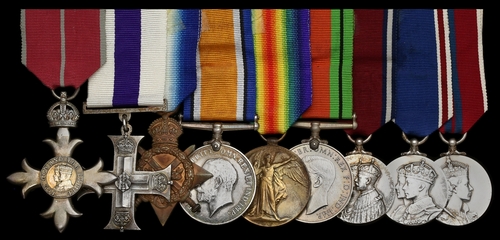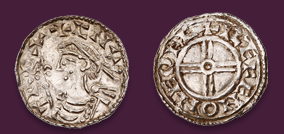
Auction: 25002 - Orders, Decorations and Medals
Lot: 132
The Second World War M.B.E., Great War M.C. group of nine awarded to Major C. H. W. Pugh, King's Shropshire Light Infantry
An ex-Royal Fusilier from one of the Public School Battalions, he was twice wounded on the Western Front and commanded the Oswestry Home Guard in the last war
The Most Excellent Order of the British Empire, Military Division, Member's (M.B.E.) breast Badge, 2nd Type, silver; Military Cross, G.V.R., the reverse privately engraved, '2 Lt. C. H. W. Pugh, 3rd Aug. 6th K.S.L.I.'; 1914-15 Star (PS-3118 Pte. C. H. W. Pugh, R. Fus.); British War and Victory Medals (Lieut. C. H. W. Pugh); Defence Medal 1939-45; Jubilee 1935; Coronation 1937; Coronation 1953, very fine or better (9)
M.C. London Gazette 18 July 1918, the original citation states:
'For conspicuous gallantry and devotion to duty when in command of a platoon in an attack. When the advance was checked he reinforced the leading wave on his own initiative and enabled the advance to continue. He led his men to the final objective with great vigour and twice assisted another platoon by covering the advance with Lewis gun fire when they were held up. He showed splendid leadership and initiative.'
Cyril Henry Wallace Pugh was born in Oswestry, Shropshire on 11 November 1889 and was educated at Oswestry Grammar School, where he represented the school in all the major sports and became head boy; his tough sporting demeanour gained him the nickname 'Old Iron'. But he also excelled in the classroom, gaining a place at St. John's College, Oxford, where he became an exhibitioner and took a 1st in Law. He then settled down to life as a solicitor in the family firm Minshalls, Parry-Jones and Pugh.
In September 1914, following the outbreak of war, he enlisted as a private soldier in the 21st (Public Schools) Battalion of the Royal Fusiliers, in which capacity he was embarked for France in November 1915. In common with many of his comrades, however - and owing to heavy officer casualties - he was among those commissioned when the battalion was disbanded in April 1916, in his case in the 3rd Battalion, King's Shropshire Light Infantry.
Subsequently attached to the 6th Battalion, he likely joined it on the Somme before the end of the year. Certainly, he is known to have been wounded on 11 February 1917, although the exact nature of those wounds remains unknown.
Back in action in time for the battle of Cambrai, he was awarded his M.C. for the battalion's costly actions on 20-21 November 1917, when company command devolved to a Captain and three 2nd Lieutenants. Pugh appears to have emerged unscathed from these actions, but his luck ran out on the 25th, when he received his second wound; the date engraved on the reverse of his M.C. likely relates to his subsequent investiture.
Returning to Oswestry at the war's end, Pugh became a partner in the family firm after his father's death in 1921. But he was also an active member of the 4th Battalion, K.S.L.I. (Territorials), and only stood down on reaching the age limit in the early 1930s. And with the renewal of hostilities, he was a natural candidate to command the local Home Guard in the rank of Major, in which role he was awarded his O.B.E.
Pugh was otherwise a stalwart of the scouting movement, gaining appointment as District Commissioner for north-west Shropshire. And he was one of the leading entomologists in the country, his collection being donated to the Manchester Museum on his death in March 1973; sold with a file of copied research.
Subject to 20% VAT on Buyer’s Premium. For more information please view Terms and Conditions for Buyers.
Sold for
£1,300
Starting price
£1200




